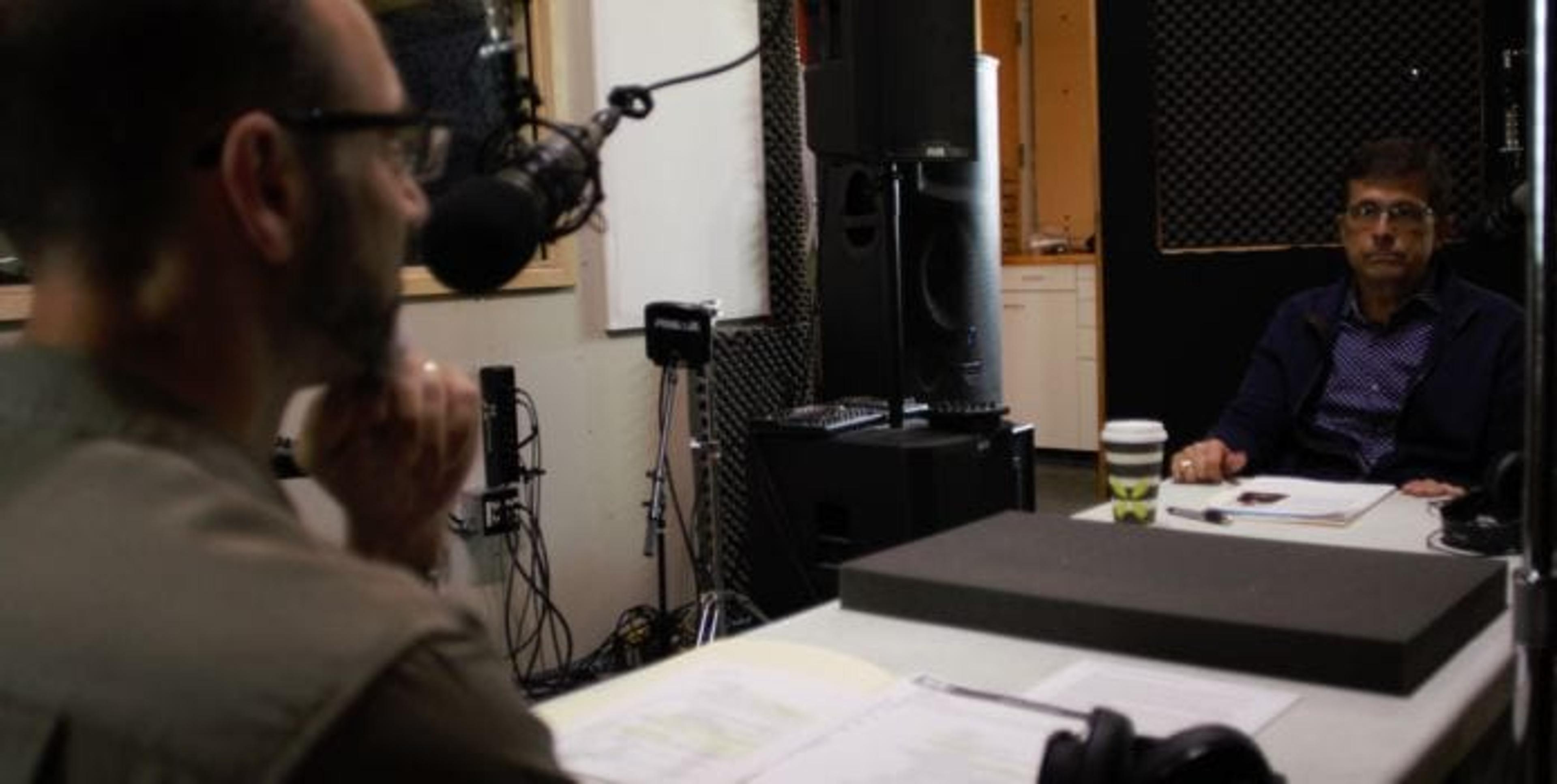Benefits of Stress
| 1 min read

00:00
00:00
About the Show
On this episode, Chuck Gaidica and Dr. Duane DiFranco discuss how to respond to stress and use it to our advantage.
“It’s meant to be good… If our stress motivates us to make changes, if we respond to it by better time management, or solving the problems that are creating it in the first place, we can really get it working for us.”– Dr. Duane DiFranco
In this episode of A Healthier Michigan Podcast, we explore:
- How stress can yield positive results.
- How to enhance the effectiveness of your stress response.
- Why self-observation is important.
- Recognizing your thoughts, behaviors, and their consequences.
- How to practice the Four Column Technique.
Transcript
Chuck: This is A Healthier Michigan Podcast, episode 14. Coming up, we discuss how stress can actually be a good thing.
Chuck: Welcome to A Healthier Michigan Podcast, the podcast dedicated to navigating how we can improve our health and well-being through small healthy habits we can start implementing right now, and practice makes perfect. Oh, are we going to learn something about that today. I’m Chuck Gaidica. Welcome back. Each week, we’re sitting down with a certified health expert from Blue Cross Blue Shield of Michigan. We go into topics covering nutrition and well-being and stress reduction. And today, a little bit on good stress and how we can deal with it. We’re going to do that with Dr. Duane DiFranco, who’s here. A board-certified psychiatrist, currently senior medical director at Blue Care Network of Michigan. He’s gone to Notre Dame. He’s gone to U of M. He’s got an MD. He’s here to help us understand this. It’s good to have you back. Good to see you.
Dr. DiFranco: Thank you, Chuck. Good to see you, too.
Chuck: It’s a great day to be alive and to understand that somehow if we get stress, it’s an okay thing. There is good stress, right?
Dr. DiFranco: It’s meant to be good. Our body wants it to be good for us. How can that be? If our stress motivates us to make changes, if we respond to it by better time management, solving the problems that are creating it in the first place, we can really get it working for us. And actually, I just mentioned time management and problem solving. These are skills that can be learned. Those who are very good managers of their time, budgeting it, etc., those who see a problem, generate solutions, choose a solution, realize there’s no such thing as a perfect solution and force themselves to feel okay about that, really can get their stress working for them.
Chuck: But you know, that time management thing, for me I try to do it in my head. I let my smart phone help me. My wife, it’s planned out. One of our sons just told me the other day, “Dad, you’ll love this as a pilot. There’s a book on checklists.” I said, “Somebody wrote a book on checklists?”
Dr. DiFranco: Absolutely.
Chuck: It’s a time management book. There must be others. But it’s all about having checklists in life. You relate to it as a pilot. Go through this checklist. Make sure the wheels are there. Make sure the engine’s starting. You go through checklists in everyday life, and yet you don’t think about check listing how you’re even doing your personal things. You do it in your brain, but you may forget.
Dr. DiFranco: Right. And we only have so much time, just like we only have so much money. I think we probably don’t budget our money as often as we should, but we certainly don’t budget our time as often as we should. Setting priorities, deciding how much time should I spend. I want to spend an hour. I don’t have an hour, so I’m going to have to do the half hour version of this job. That sounds more restrictive, but budgeting can be a very freeing exercise because it’s not so much, well I can only afford to do the half-hour version of this task when I want to do the full hour, so that’s very restrictive. No. It’s I can only afford to do the half-hour version of this task because I’m prioritizing another task for the full hour. That winds up feeling pretty good, being much less something to be feared than we think it is before we start.
Chuck: I was thinking in a nostalgic way after our last episode about things that came up. If you’re old enough to remember the song Don’t Worry Be Happy.
Dr. DiFranco: Oh yeah.
Chuck: I mean, what a great song. You whistle the song. Then the smiley face. Just a yellow circle with a smiley face. I think, how many answers can we bring to life relative to stress if we just took a simpler path? To answer, you’re helping us with a lot of these questions. You gave us a great example in the last episode about this ancient cave person, Fred Flintstone. Fred and Barney are out there and the saber tooth tiger jumps out. They’ve got this fight or flight response. Either I attack back to preserve my living, my being, or I’m going to run like heck. When we talk about these responses, these stressful responses to the stressor, the saber tooth tiger … Am I good so far?
Dr. DiFranco: Yes. You got it.
Chuck: I’m learning, from episode 13. What is the effectiveness? How can we enhance the effectiveness of this response that we come up with to stressors in our life?
Dr. DiFranco: Beautiful. There’s a first step. Well, there’s a prologue and then a first step.
Chuck: All right. Is this going to be a checklist? I’m going to make notes.
Dr. DiFranco: It’s a bit of a checklist. You make notes.
Chuck: Okay. Go ahead.
Dr. DiFranco: The caveman, he just had a spear and he had his legs, and he had to run or he had to fight. Our lives are much more complicated than that. Well, we need to turn that into an advantage and use the fact that we’ve got pen and paper and pads and books and iTunes to our advantage. There’s a lot that we can do to use those tools to help us with our stress. So, the prologue is when we recognize that we’re stressed, the stress is there as a warning signal to ourselves. It’s like a message to ourselves. We ought to listen to it. We ought to realize that because we’re having a stress response, that means we’ve got a problem to solve. Too often, we procrastinate or we ignore it. We tend to be like ostriches, put our heads in the sand, and then things only get worse.
Chuck: Because you pointed out in our last episode, you now get stressed about the things that were stressing you because you didn’t act in any way.
Dr. DiFranco: Correct. Part of the reason that people do that is they don’t think there’s an alternative. They just think that this is the way I am and this is the way it’s always been, and what we’re here to tell people is that’s not true. You can do something about it. So, the prologue is find out that you’re stressed and either solve the problem or determine how much of it is over exuberance. Then we want to bring that over exuberant part of the response down to earth so that we’re reacting to things more realistically. So, the first way you do that is through self-observation. You might think you know your stress response very, very well because it’s there all the time and it’s plaguing you. That might be true, but then again there might be components of it that you’re ignoring that are very important.
Dr. DiFranco: So, the first step to solving your stress problem is self-observation. There’s a very specific paper and pencil exercise that you can do to help you do that. Let me just say, by way of a bit of a detour, that doing these exercises, actually writing them down, is very important.
Chuck: Is it like journaling in a way then?
Dr. DiFranco: It’s absolutely like journaling. It could be a part of your journal. It could be a page in your journal. Because there’s a part of your brain that slows down and recognizes things in a very impactful way when the message goes from your brain to your arm, from your arm to paper, from the paper to your eyes, from your eyes to your brain. That circuit engages other parts of the brain that make the experience and the information much more usable to those parts of your brain that work more emotionally and more automatically.
Chuck: Can I admit something to you?
Dr. DiFranco: Please.
Chuck: I’ve been through a process called halftime, where I had to journal. I know there are people listening right now who think, “Write stuff down in a little book with … I’ll go buy one. It’s got nothing written in the pages. Or somebody gives me one for Christmas or something.” I have to admit to you, I got a journal. I thought, “This is the dumbest thing.”
Dr. DiFranco: Sure, yeah.
Chuck: And as soon as I started doing it-
Dr. DiFranco: Then you know.
Chuck: I’m thinking, oh my god. It was like breathing some fresh air. I can’t even explain. You know what you’re talking about obviously. I’m just telling you. There are people I bet right now listening going, “I would never in a million years write stuff in a book.” When I started to do it, and then sometimes went back and reflected, it was powerful.
Dr. DiFranco: Yes. I admit it too. It does seem kind of … I don’t want to say hokey. Oh, I’m going to write this stuff. I’m going to write it down. I’ve got to go get a book. Is it really that bad? Well, you don’t know until you try, number one. Number two, if you’re worried about your stress and it’s impacting you negatively, sure it’s worth trying. It’s not that big of a deal. Let me explain how the self-observation works. It’s really pretty simple. It’s a four column technique. It should be done every day. The purpose of the exercise is to make you more aware of the types of things that stress you out, what your response is, and what the consequences are, so that you can be motivated to do some of the other things we’ll talk about in later podcasts to help reduce your stress, and so that you can focus your interventions.
Dr. DiFranco: I liken this to aiming your fire extinguisher at the base of a fire. You’ve got a fire to fight, you’ve got a fire extinguisher. It’s a good one, but if you’re aiming it at the tips of the flames, you’re not going to put the fire out. Well, we’ve got some great tools, some great fire extinguishers to give to people, but they need to be focusing them at the base of their fire. For everyone that’s a little bit different, and you don’t know what your particular individual stress response is like until you’ve done some of these self-observation exercises.
Chuck: So, am I writing these four columns in advance to start my day? Because I can’t anticipate all the stressors that are going to come up.
Dr. DiFranco: I would recommend you do it at the end of the day, or right after a stressful event.
Chuck: Interesting.
Dr. DiFranco: Let me give you an example. The four columns are, first of all, column one, the event. This corresponds to the stimulus or the stressor, the thing outside of me that happened that made me feel stressed. Column number two, my stress response rating. This is simply a number from 1 to 100, how much stress did this generate. How strong was my stress response? Column number three, what was my response to it? When I say my response, I don’t mean my purposeful conscious response. I mean my stress response. Remember, there’s four components to the stress response. You write something for each of those components. Now, not all four things will necessarily be important, but all four things will be present.
Chuck: And what are they again quickly?
Dr. DiFranco: The thoughts that I had, the feelings that I had, the behaviors that I engaged in, and the physiologic response that I had.
Chuck: All right. I want to come back to that one. So give us, what’s in the fourth column?
Dr. DiFranco: And then the fourth column are the consequences that ensued. By way of example, the event. My boss corrected an error that I made. My stress response rating, it really bothered me. It bothered me all afternoon. I couldn’t concentrate. Oh, I participated. I guess I did reasonably well. I felt a little upset in my stomach maybe. 65. Out of 1 to 100, it was pretty bad. Not horrible. It was a 65. What was my stress response? I had a couple of thoughts. I didn’t know that I was having them until I sat down to do this exercise, but when I asked myself, “What kind of thoughts was I having after that,” I realized I was thinking to myself, “My boss hates me. She’s got it in for me. I’m no good at this job.” Then what was I feeling? I was feeling depressed.
Chuck: Could be sad.
Dr. DiFranco: I was feeling sad. So, I’d list those things. What was my behavior? I apologized to her and I came up with a lame excuse. I wanted to shut it off. Maybe that was my response. Again, just by way of example. I canceled an appointment later in the day because I thought I couldn’t handle it. Physiologically, I felt my stomach wasn’t right. It came time to eat lunch. I was hungry an hour before that happened, but it came time to eat lunch, I didn’t feel like eating, and I got a little bit of a headache in the afternoon and noticed that my brow was very furrowed.
Chuck: Interesting. Let’s talk about that because this idea, you’re a psychiatrist. We’re talking a lot about the mind. You’re talking about watching, writing on paper with a pen or a pencil. It comes back through your eyes to your brain. I’m getting all that. I love this. I love the test. The idea though that there are physiological manifestations of something happening in the mind, we can articulate it and we can know, oh yeah that makes sense, and yet we don’t realize that something that’s actually happening to us, physiologically to our bodies is directly related to that stressor event. Right?
Dr. DiFranco: That’s exactly right. And there are people who don’t have much of an emotional reaction to stress. I think people who think that they’re more stressed out than the average person might be. It might be because they have bigger problems to solve. It might be because they’re wired for a little bit more of an exuberant response. They’re going to get more out of the exercises that we’re going to be taking people through, but they can’t make the mistake of assuming that because one of their co-workers or one of their bosses that they emulate and want to be like is always calm, always in control, always smiling, that that person doesn’t have stress. We all have stress. So, we know they’re having it. They may be having it in some ways that are worse than the person who experiences it very emotionally. They might be having it almost purely physiologically.
Chuck: In the last episode, I talked about my son, who’s got an autoimmune disease. I mean, that could be anything from arthritis to Crohn’s. It’s a myriad of diseases that someone could have. Oftentimes it’s a smorgasbord. This is the kid that’s got the steady as it goes, hey there’s a spaceship in the yard, and he just walks away going, “Cool. Mom, look. It’s glowing.” I mean, really that would be the stress level.
Dr. DiFranco: And you’d say, “I want to be like him.”
Chuck: Exactly.
Dr. DiFranco: He doesn’t have stress.
Chuck: Right. The other kids in the family are saying, “Why can’t I be like this guy?” At the same time, because of his physical thing, we have seen in his life stressors. He tripped and twisted his ankle while playing football with the guys in a pothole. All of a sudden, he has a physiological reaction. The stress was not from a boss of from somebody yelling at him or mom and dad saying, “Go into your room.” He had a physical stress.
Dr. DiFranco: It’s a physical stress, yeah.
Chuck: That then becomes an issue that manifests itself. Fascinating for the same kid that doesn’t have much trouble getting through life.
Dr. DiFranco: Your story reminds me of a patient I once treated who came to me at the urging of his sibling, who had an anxiety disorder, the sibling did, and recognized that her brother may be suffering from some of these things. He didn’t think he had any sort of anxiety problem whatsoever. In fact, in a certain sense, he didn’t because he was always very calm. He had a very stressful job, timeframes, problems, but he would never feel stressed, so he didn’t think he was. But he would experience stomach bloating, physical stomach bloating to the point where he would have to loosen his belt every day for a couple of weeks when deadlines were due. He never connected it that this was a stress response, but he was an individual who had not much of an emotional response, not much of a thought response. His was a physiologic response.
Chuck: Let’s wrap it up because I want to make this a takeaway for everybody. The four columns is something we’re going to start to practice. I learned from you in the last episode, and again off mic here before we got started. Practice really does make perfect when trying to deal with some of these things. What did you say? How many weeks, if we get in the routine of practicing anything?
Dr. DiFranco: What’s really great is if doing exercises like these can become habit, and research shows that you have to do something regularly for at least three weeks or so before it comes a habit, before you start doing it without even really reminding yourself that you have to. So, keep it up. Every day, journal your four columns self-observation. You do that for three weeks, and you won’t have to think about it anymore.
Chuck: If I stay on my diet for at least three weeks, I’m better off to stay on my diet?
Dr. DiFranco: This applies to just about any habit. That’s true.
Chuck: All right. Dr. DiFranco, good to have you back. We’ll be back with Dr. Duane DiFranco on our next podcast as well. Listen, if you’re like me and you listen to this, and you heard this idea of having four columns. What’s at the top? What am I writing in? You want to go back and listen again, we encourage you to do so. This is A Healthier Michigan Podcast, brought to you by Blue Cross Blue Shield of Michigan. If you want to learn more, go back and repeat episodes and make some notes for yourself about what you can do to start to practice here, go to AHealthierMichigan.org/podcast. All of our episodes are there for you to play through over and over again if you like. You can leave us a review or a rating on iTunes and Stitcher. You can also download these, subscribe to Apple podcast, Stitcher, or your favorite podcast app.
Chuck: Next time, when we get into our next episode, which will be 15, we’re going to talk about the difference between stress, anxiety, and other diagnosable conditions. The doctor is in the house, Dr. Duane DiFranco. I’m Chuck Gaidica. Make it a great day.





